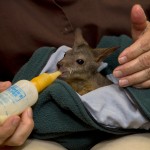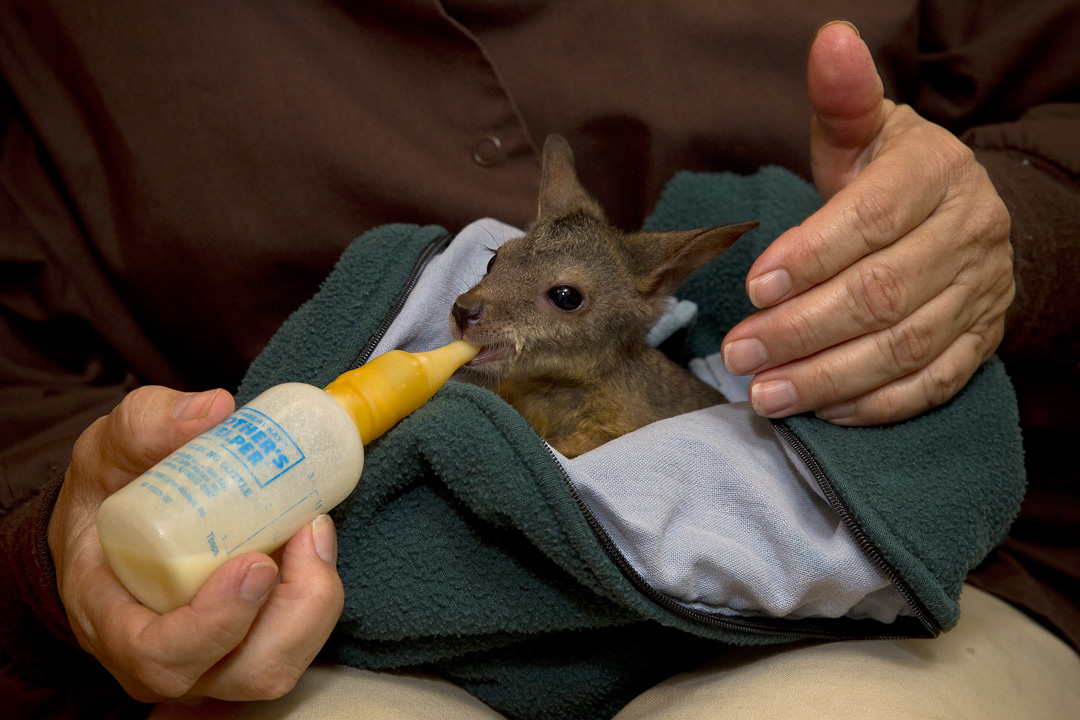Clik here to view.

Clik here to view.

Clik here to view.

Tinka enjoys a special milk formula from the safety of her manmade pouch.
Be sure to read Janet’s previous post, Parma Wallaby Baby: Life in the Pouch.
We had been keeping Tinka’s environment quiet, comforting, and secure to simulate the environment of her mother’s pouch. Now the emergence of Tinka’s new coat meant that it was time for her to begin stepping out in the world. It was also time for us to change some of our care techniques.
The first step was to change her milk formula. Finding just the right milk formula at the proper time is one of many complex responsibilities of our Nutritional Services Division. Just imagine creating a healthy diet for hundreds of species of exotic birds, mammals, and reptiles, both here at the San Diego Zoo and at the San Diego Zoo Safari Park! It is a tall order but is probably most complicated when dealing with exotic neonates like Tinka. We are inordinately lucky to have a staff of on-site nutritionists at our disposal, and ours are the best in the world.
Biolac is the name of the product that we use to bottle-feed pouched mammals like Tinka. This dry powder is specially formulated and balanced to provide all essential nutrients needed for growth and good health. Biolac comes in three formulations to match stages of development, much like some products for human babies.
Since her arrival in the nursery, we had been feeding Tinka powdered Biolac M100. The powder is carefully measured and mixed with water. The first-stage powder is intended for joeys in the most unformed, hairless state. Now that fur had developed it was time for the switch to the next formulation, called M150. It is important not to make drastic diet changes quickly, so our Zoo nutritionists helped us design a plan for switching Tinka over slowly. We added only 25 percent of the new powder every four days to ease the transition until it was complete. Tinka did fine, and her weight continued to climb.
Tinka’s teeth were coming in, a signal that it was also time to introduce solid foods and begin the weaning process. To wean an animal, we gradually decrease the number of bottle feedings given per day and offer solid foods to replace them. The natural diet of the parma wallaby includes leaves and grasses, which are high in plant fiber. Wallabys rely on bacterial fermentation to help them digest their food. If Tinka were being reared by her mom in the natural situation, she would be exposed to bacteria every day. To simulate this natural process, we do a series of transfaunations. We take a tiny amount of fresh poop from the adult group and feed it to the baby. This process inoculates the joey’s gut with the beneficial bacterial that is necessary for proper digestion. Once the transfaunations were complete, we began offering Tinka some solid foods. The adult diet is composed mainly of a pellet made for wild herbivores. We were surprised that Tinka liked her pellets from the beginning, sometime preferring the softer soaked ones, and other times munching on the hard, crunchy dry ones.
Clik here to view.

Tinka enjoys the outdoors.
Along with the solid food, social time was added to her daily routine. Each day we brought Tinka out to a nice roomy pen behind the adult parma wallaby enclosure. This off-exhibit area was perfect because it was big and sunny with trees and dirt, all new to Tinka. The best part was that after Tinka was used to the pen area, we could open a small partition and allow her to socialize with an adult female parma wallaby.
From the beginning, Tinka loved her excursions outside the nursery. She stretched out in the warm sun and enjoyed the freedom of hopping around and exploring. We could not believe how fast she could move around and how coordinated she was. Tinka’s brief nose-to-nose encounters with the adult female parma wallaby were brief but positive. When the two animals spotted each other, they did a rapid headshake movement, complete with a hilarious ear vibration. This traditional greeting, performed when parmas meet, was all new to Tinka, but she displayed it perfectly on her own without ever having seen it before.
Gone were the days of the incubator environment. Tinka was living in a cozy box pen in the nursery with only a heat disk necessary to keep her pouch warm. Tinka’s new coat made it possible for her to explore a new exciting world and to form new relationships.
Janet Hawes is a lead keeper at the San Diego Zoo.